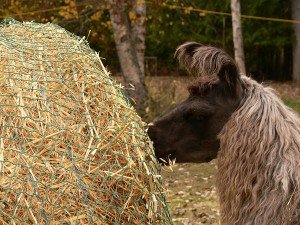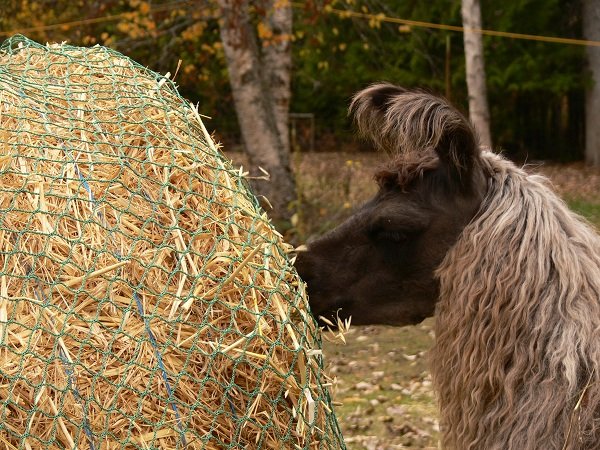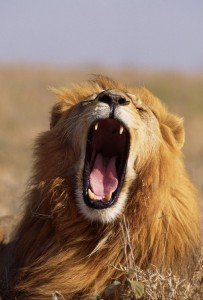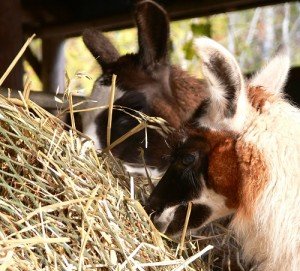Feast and Fast Feeding
Lions, tigers, wolves and snakes, the big carnivores, all eat large meals at long intervals and then sleep during digestion. Herbivores on the other hand, the browsers and grazers, need to eat throughout the day. They have to work a lot harder to extract nutrients from
their food. In the wild, camelids spend almost the entire day moving around from place to place, browsing on available foliage. At certain times they must sit down and assist the digestion through rumination.
Herbivores kept in captivity however, are often fed at specific times of day. In winter, hay is usually provided in bunks, troughs or byres to keep it off the ground, but since it arrives all at once and there is competition to grab the best bits or the best place at the feeding station, llamas and alpacas are encouraged to eat in an unnatural way. They gobble as much as they can in one session and then head off into the corner to digest. They are in effect, eating according to the ‘feast and fast’ system of carnivores. For camelids, this is completely unnatural behaviour, which can and does have serious health implications for the animals, so managed.
The stomach continues to produce strongly acidic gastric juice throughout the day. Saliva on the other hand, is alkali, which helps to balance the pH of the fermentation process going on in the stomachs, as well as adding lubrication and enzymes to aid the digestion. It may also assist in mopping up acid spills on internal surfaces that do not possess the incredible protection system that prevents the body from digesting itself! Didn’t your mother always tell you to chew your food thoroughly?. Cows produce an astonishing quantity of saliva, upward of 15 gallons a day. According to what I have read, the average horse, if such a creature exists, produces around 6 gallons a day. Although I haven’t found  any studies that quantify the amount of saliva that a llama produces, and to be truthful, I don’t care for more animals to be experimented upon, in order to determine that figure, I think it’s safe to say that it’s a comparatively huge quantity.
any studies that quantify the amount of saliva that a llama produces, and to be truthful, I don’t care for more animals to be experimented upon, in order to determine that figure, I think it’s safe to say that it’s a comparatively huge quantity.
If the acid-neutralizing saliva is lacking at any time, acidity can increase to a dangerous level, causing colic, ulcers and other digestive complaints. In grazing animals that feast only once or twice per day, the natural balance of acid and saliva is disturbed and ideal conditions for digestive upsets are being established.
A few of the llamas in our own herd are possessed of teeth that grow more rapidly than those of the rest of the herd. Whilst eating hay during the winter months, they are not using their incisors in the same manner and their front teeth become elongated. Once the snow melts and they return to pasture, it takes a few weeks before they grind their teeth down to a practical length once more. This is due to the fact that eating hay does not require much effort from the incisors.
At our previous farm, we grew our own hay and always had a surplus. The few llamas that we had at the time, could revel to their hearts content inside one of several ‘hay stations.’ Unfortunately, for the last two years we have been reliant upon buying hay and have therefore needed to regulate the amount of hay being fed to the rapidly increasing herd of rescued llamas and alpacas. Digestive complaints have been common and it seems that we are always treating one or more of the animals for diarrhea or constipation or bloating and even colic. This year, however, we acquired several NAG Bags, slow-feeder nets to contain the hay and the difference they have made to the herd is astonishing.
The All Day Breakfast
NAG Bags are heavy nets that wrap around the bales or flakes of hay and they have revolutionised our feeding system!
Firstly, we no longer have manic feeding times. The crazy episodes of pushing and shoving and spitting (from the llamas, not Lynne and I ….although I have felt the occasional urge to join in!) twice or more a day; breaking open bales and making sure everyone is getting a place at the bunks. It’s certainly not that we begrudge spending that time with the llamas, but our time can be more beneficially spent doing other things with them. The slow-feeding nets have restored the peace that we used to experience when they had all day access to hay.
Recent rescues having no trouble with the net
Secondly, the spoilage has been reduced dramatically. No matter what type of feeding system we have tried, the llamas drop a lot of food on the ground as they posture, snort and jostle for position. I’m sure all llama keepers have noticed the two distinct methods of eating. The animal either grabs a mouthful of hay and waves his head around to maintain his position or she burrows into the hay so that her face is completely protected from both eye contact and over-spit from someone else’s argument. The first method sees a lot of the hay scattered around and the second system wears the fibre off the animals nose, leaving a bald patch, that is sometimes confused with mineral deficiency.
We have yet to see the longer term benefits resulting from this slow feeding system, but watching the llamas having to use their teeth to extract the hay from the net, I am in no doubt that their teeth will remain in good condition throughout the winter months.
Calm without Storm
The most astonishing effect of feeding the animals using the NAG Bags though, is the  absence of fighting over food. Since they have access to hay all day long, the less demonstrative of the herd and in particular, the new-comers, who are incredibly timid, all have ample opportunity to feed. Not only that, but the girls especially, are keen to leave the corral and barn in the morning and head off into the forest or the paddocks for a rambling graze. In previous years, they would hang around the stall until all the hay had gone and then they would be moody and grumpy with each other and we would have to force them to go for a walk, further upsetting them. All that has ended by simply placing the bales in nets.
absence of fighting over food. Since they have access to hay all day long, the less demonstrative of the herd and in particular, the new-comers, who are incredibly timid, all have ample opportunity to feed. Not only that, but the girls especially, are keen to leave the corral and barn in the morning and head off into the forest or the paddocks for a rambling graze. In previous years, they would hang around the stall until all the hay had gone and then they would be moody and grumpy with each other and we would have to force them to go for a walk, further upsetting them. All that has ended by simply placing the bales in nets.
Fitting the net – with some help
Due to difficult storage conditions and the lack of tractor room around the barn, we have had to feed square bales, but having spent a lot of time and money rearranging fences and enhancing the barn, we are back to feeding round bales, which is considerably cheaper. Presently, we are feeding 4×4 bales of oat hay, but since the oat bales tend to be misshapen, we are using nets large enough to take 5×5 bales. NAG Bags are also available in ‘monster bale’ 6×6 size, as well as square bale size and a loose hay net designed for hanging in a stall.
Having witnessed llamas ripping tarpaulin and silage plastic to shreds, in order to reach the contents, I had expected the bags to be treated with similar contempt. The nets are tough though and yet soft, so as not to abrade the lips and I haven’t seen any of the girls tugging at the netting. NAG Bags sells them with either one inch holes or inch and a half holes. They recommend starting with the larger holes for horses, to get them used to the idea of ‘singing for their supper’. We also opted for the inch and a half size, thinking that  the llamas might have a hard time pulling the hay through the mesh. Ha! Camelids have the dexterity of a dentist and their prehensile lips could pull a carrot through a keyhole! The shaggy ‘gang’ looked at their freshly installed, net-clothed bales, scowled at us with a ‘what’s all this about’ look and then piled in. Within minutes they were all happily munching, ten to a bale. I wonder now whether the one inch holes would have been better!
the llamas might have a hard time pulling the hay through the mesh. Ha! Camelids have the dexterity of a dentist and their prehensile lips could pull a carrot through a keyhole! The shaggy ‘gang’ looked at their freshly installed, net-clothed bales, scowled at us with a ‘what’s all this about’ look and then piled in. Within minutes they were all happily munching, ten to a bale. I wonder now whether the one inch holes would have been better!
Our oat bales weigh between 550 and 600lbs and on average we are adding one new bale per week for around 26 llamas. That works out at a little over 3lbs per day per animal. Since they are supplementing their hay with a little forest foraging that’s still available to them, at least until the snow settles in for the long haul of winter, we expect that figure to rise, but we won’t need to worry about over or under feeding anymore. There is still a little wastage, but we had intended the discarded oat hay to create bedding as well, so from our point of view the system is working perfectly.
Either way, the difference that this slow feeding system has made to everyone at The Llama Sanctuary, is sufficiently impressive as to want to share it with all camelid keepers. This is one of the best investments we have made in the health care of our tribe. The feeding system makes perfect sense, health-wise, time-wise and money-wise and it is a joy to be in the midst of a calm group of girls once more.
For more information about NAG Bags visit http://www.slowfeeder.com





Trackbacks/Pingbacks